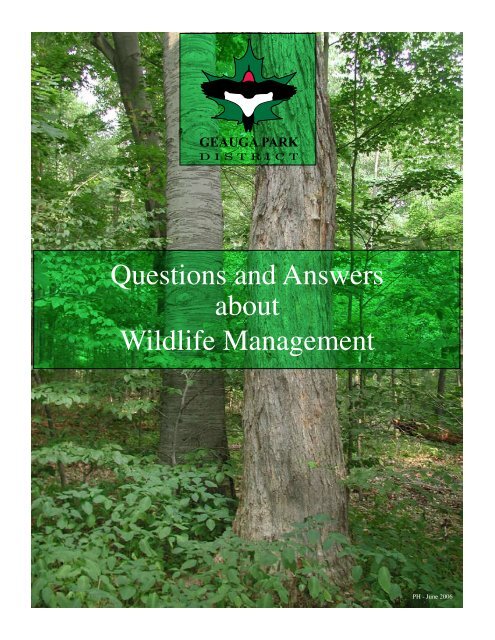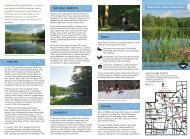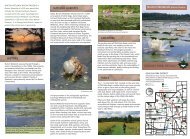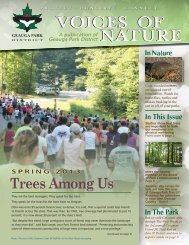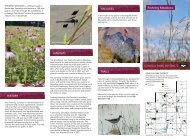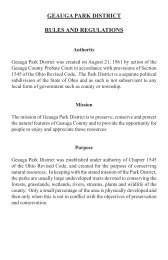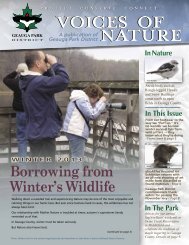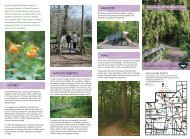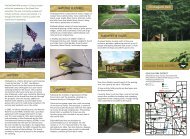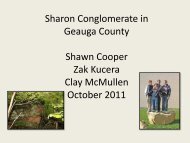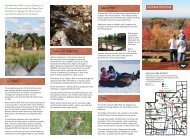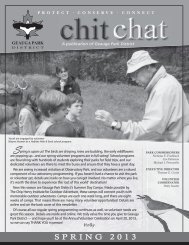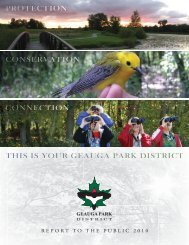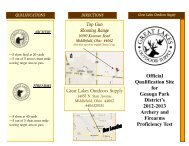Questions and Answers about Wildlife Management - Geauga Park ...
Questions and Answers about Wildlife Management - Geauga Park ...
Questions and Answers about Wildlife Management - Geauga Park ...
You also want an ePaper? Increase the reach of your titles
YUMPU automatically turns print PDFs into web optimized ePapers that Google loves.
<strong>Questions</strong> <strong>and</strong> <strong>Answers</strong><br />
<strong>about</strong><br />
<strong>Wildlife</strong> <strong>Management</strong><br />
PH - June 2006
NATURAL RESOURCE MANAGEMENT<br />
The mission of the <strong>Geauga</strong> <strong>Park</strong> District is “to preserve, conserve, <strong>and</strong> protect the natural features of <strong>Geauga</strong><br />
County <strong>and</strong> to provide the opportunity for people to enjoy <strong>and</strong> appreciate those resources.” A portion of the<br />
<strong>Park</strong> District’s mission refers to conservation, the active care of our l<strong>and</strong>. Natural resource management is the<br />
process of providing active conservation stewardship, or care of plant <strong>and</strong> animal species within the various<br />
habitats. It often requires proactive measures to control both invasive plants <strong>and</strong> animal species that alter the<br />
balance <strong>and</strong> health of a natural area. As public <strong>and</strong> private l<strong>and</strong>owners, we can all do our part to ensure good<br />
management <strong>and</strong> stewardship are part of our conservation ethic.<br />
WILDLIFE MANAGEMENT<br />
<strong>Geauga</strong> <strong>Park</strong> District faces many challenges in maintaining healthy wildlife communities. <strong>Wildlife</strong> like<br />
whitetail deer, wild turkey, beaver, muskrat, eastern coyote, <strong>and</strong> other species have adapted to l<strong>and</strong>scapes<br />
developed by humans. This adaptation has resulted in growing animal populations although there is not<br />
sufficient natural habitat to support the needs of all species. This results in a<br />
lack of food <strong>and</strong> shelter for wildlife, the destruction of native plant species, <strong>and</strong><br />
competition between animal species for the available food sources.<br />
Additionally, some of the cultural impacts of wildlife overpopulation are<br />
increased numbers of vehicle/wildlife collisions, <strong>and</strong> damage to crops <strong>and</strong> private<br />
l<strong>and</strong>scaping. Species like beaver <strong>and</strong> muskrat sometimes pose a challenge to<br />
natural resource managers, because they burrow into the dams of lakes <strong>and</strong> ponds,<br />
<strong>and</strong> cause significant damage to roads <strong>and</strong> neighboring properties.<br />
In order to counteract some of these challenges, <strong>Geauga</strong> <strong>Park</strong> District utilizes a<br />
number of wildlife management practices. In 2006, <strong>Geauga</strong> <strong>Park</strong> District Board<br />
of <strong>Park</strong> Commissioners approved a wildlife management policy to allow controlled<br />
hunting. At times, controlled trapping is used to maintain beaver <strong>and</strong> muskrat.<br />
The purpose of this document is to provide answers to the most frequently asked questions <strong>about</strong> <strong>Geauga</strong> <strong>Park</strong><br />
District’s <strong>Wildlife</strong> <strong>Management</strong> Policy, <strong>and</strong> its implementation.<br />
1) Does this policy allow for open hunting in the parks<br />
At no time, will <strong>Geauga</strong> <strong>Park</strong> District properties be open for public hunting or trapping. Hunting or trapping<br />
as wildlife management tools will be strictly controlled. <strong>Wildlife</strong> control will only occur on specific dates<br />
on selected properties identified by <strong>Geauga</strong> <strong>Park</strong> District Board of <strong>Park</strong> Commissioners, <strong>and</strong> only licensed<br />
sportsmen <strong>and</strong> sportswomen who are residents of <strong>Geauga</strong> County will be selected to participate.<br />
2) What other choices of wildlife management tools have been used in other parks, <strong>and</strong> how<br />
have they worked<br />
<strong>Park</strong>s, public, <strong>and</strong> private agencies in Ohio have experimented with four different methods for controlling<br />
wildlife populations. They include:<br />
1) Do Nothing – “Let nature take its course”<br />
Result – Currently, habitat loss is the single largest impact to species worldwide. As <strong>Geauga</strong> County<br />
continues to exp<strong>and</strong> <strong>and</strong> develop homes <strong>and</strong> businesses, habitat is displaced. Any animal has the<br />
potential to outgrow <strong>and</strong> displace other species within its habitat. If these species are not managed in a<br />
pro-active manner, our list of rare, threatened, endangered, <strong>and</strong> extirpated species will continue to grow.
2) Contraception/Sterilization<br />
Result – Various agencies, including Clevel<strong>and</strong> Metroparks, have experimented with contraception as a<br />
tool to control wildlife populations. This method is proven ineffective in controlling deer populations.<br />
One of the biggest challenges in achieving sufficient results with this method is implanting or sterilizing<br />
a sufficient number of animals to control the population. Furthermore, contraception is not approved by<br />
state <strong>and</strong> federal agencies because it is introducing an unnatural chemical into a wild population.<br />
3) Sharpshooting<br />
Result – Sharpshooting is the process of using a hired consultant to “cull” or eliminate a portion of a<br />
wildlife population. This process has proven effective for whitetail deer in local parks <strong>and</strong> communities.<br />
Unfortunately, the process is usually implemented after natural resources suffer significant or drastic<br />
damage. At this point in time, park commissioners have determined it would be preferable to allow<br />
<strong>Geauga</strong> County sportsmen <strong>and</strong> sportswomen to assist in the process of controlling wildlife populations.<br />
4) Controlled hunting<br />
Result – Hunting is a wildlife management tool used throughout the world. The process of allowing<br />
sportspersons to harvest wildlife has been proven effective at maintaining healthy populations in a park<br />
setting. In many ways, utilizing controlled hunting could be compared to fishing on park property. To<br />
ensure the health of ponds or lakes <strong>Geauga</strong> <strong>Park</strong> District allows anglers to remove fish, thus ensuring the<br />
entire aquatic system remains healthy. In the same way, wildlife species must sometimes be removed to<br />
ensure species <strong>and</strong> habitats remain healthy.<br />
3) Why has <strong>Geauga</strong> <strong>Park</strong> District chosen “controlled hunting”<br />
<strong>Geauga</strong> <strong>Park</strong> District has consulted with parks throughout Ohio, <strong>and</strong> has determined that hunting is a viable<br />
management option when used in a proactive approach to maintaining ecosystem health. After researching the<br />
other management options outlined above, we decided that controlled hunting is the best management option for<br />
this park district.<br />
4) How will <strong>Geauga</strong> <strong>Park</strong> District ensure that people are safe while hunts are in progress<br />
Safety will be provided by enforcing strict controls over the hunts when they take place. Strict limits will be<br />
placed on hunting areas, hunter education requirements, number of hunters allowed in the field, the type of<br />
hunting implements used for harvest, <strong>and</strong> by keeping the public informed through written letters, signs, <strong>and</strong><br />
public correspondence. Hunts will be monitored by law enforcement <strong>and</strong> wildlife officers.<br />
5) How will <strong>Geauga</strong> <strong>Park</strong> District ensure that the hunters or trappers<br />
selected are knowledgeable, safety conscious, <strong>and</strong> experienced<br />
When sportsmen <strong>and</strong> sportswomen are selected to participate in wildlife<br />
management control, they will be required to adhere to strict rules <strong>and</strong> regulations as<br />
spelled out by <strong>Geauga</strong> <strong>Park</strong> District <strong>and</strong> Ohio Division of <strong>Wildlife</strong>.<br />
1) All hunters are required to complete a hunter safety education course prior to<br />
receiving an Ohio license. Completion of a trapper education test is required<br />
prior to being certified to obtain a trapping permit.<br />
2) <strong>Geauga</strong> <strong>Park</strong> District will work with <strong>Geauga</strong> County sporting goods<br />
businesses <strong>and</strong>/or bow-hunting clubs to ensure bow-hunters complete an<br />
accuracy course.<br />
3) “Youth Hunters,” 17 or younger must be accompanied by an adult during<br />
their hunt.<br />
4) All participants will be required to attend a m<strong>and</strong>atory orientation meeting conducted to<br />
ensure safe outdoor activity.
6) How will bullets <strong>and</strong> hunters be kept away from adjacent, private properties<br />
Participants in a hunt will be required to follow all rules <strong>and</strong> regulations as spelled out by <strong>Geauga</strong> <strong>Park</strong> District<br />
<strong>and</strong> Ohio Division of <strong>Wildlife</strong>, <strong>and</strong> these rules will be strictly enforced by <strong>Geauga</strong> <strong>Park</strong> District rangers <strong>and</strong>/or<br />
other law enforcement officers.<br />
<strong>Geauga</strong> <strong>Park</strong> District regulation 12.4 specifies that “no persons shall hunt, discharge a firearm or any other<br />
weapon at any wildlife species within 200 feet of any road, structure, path, <strong>and</strong>/or parking lot; or on, across, or<br />
from any roadway.”<br />
Some smaller park properties will be deemed unsuitable for this particular wildlife management activity, if<br />
safety cannot be ensured.<br />
7) Where will a hunt be held<br />
Plans for controlled hunts will be evaluated by Natural Resource <strong>Management</strong>, Ranger, <strong>and</strong> Administrative<br />
staff at a variety of park properties. A decision on whether or not to allow hunting will be based on species<br />
population numbers, public safety, <strong>and</strong> maintaining public service for park visitors.<br />
8) When will a hunt be held<br />
All hunting activities will be approved on an individual case by case basis by the Board of <strong>Park</strong><br />
Commissioners. Hunting will be held at a limited number of park properties when the need has been<br />
demonstrated, <strong>and</strong> appropriate administrative controls are in place to conduct a safe hunt.<br />
9) How many hunters will be on a designated site at the same time<br />
The number of hunters on park property will be determined on a case by case basis with the objective of<br />
providing a safe environment for all park patrons, neighboring property owners, <strong>and</strong> the sportsmen <strong>and</strong><br />
sportswomen.<br />
10) How will <strong>Geauga</strong> <strong>Park</strong> District monitor hunts<br />
<strong>Park</strong> Rangers will assist Natural Resource <strong>Management</strong> personnel with planning, implementing, <strong>and</strong><br />
monitoring these hunts. In addition, <strong>Wildlife</strong> Officers with Ohio Division of <strong>Wildlife</strong> will assist park staff<br />
with monitoring. Hunters will be required to report their records of harvest to the <strong>Geauga</strong> <strong>Park</strong> District Natural<br />
Resource <strong>Management</strong> Department.<br />
11) How will people be notified that a hunt is scheduled, or in progress<br />
The park district will use media releases, targeted mailings to neighboring property owners, <strong>and</strong> signs to keep<br />
neighbors <strong>and</strong> park visitors informed of any controlled hunts that take place. At times, certain properties may<br />
be completely closed to the public, if necessary to ensure public safety.<br />
12) What species currently require management<br />
The purpose of <strong>Geauga</strong> <strong>Park</strong> District establishing a wildlife management policy is to effectively manage<br />
healthy populations of all species for future generations of <strong>Geauga</strong> County residents. Currently, we are<br />
managing whitetail deer populations.<br />
13) What determines that a species is “out of balance”<br />
For an ecosystem to be “in balance,” the l<strong>and</strong> must have enough resources to provide food <strong>and</strong> shelter for the<br />
animals that are living there. “Biological Carrying Capacity” is a term that refers to the maximum number of<br />
animals a park or natural area can support without affecting the health of other plants <strong>and</strong> animals.
14) What causes an imbalance of habitats<br />
A healthy ecosystem is made up of a balance of plants <strong>and</strong> animals. Over the past 200 years, <strong>Geauga</strong> County<br />
has experienced successive changes of l<strong>and</strong> use, <strong>and</strong> some species of native wildlife, such as wolves, cougars<br />
<strong>and</strong> bears, have been eliminated from the area, upsetting the balance of predators. The loss of natural predators,<br />
coupled with an abundance of food sources created by l<strong>and</strong>scaped lots, active <strong>and</strong> inactive farms, golf<br />
courses <strong>and</strong> similar development has allowed some animal populations, such as deer <strong>and</strong> turkey, to exp<strong>and</strong><br />
disproportionately. In addition, many private properties in the county are closed to hunting, resulting in<br />
uncontrolled population growth.<br />
15) What studies have officials used to make these wildlife management decisions<br />
<strong>Geauga</strong> <strong>Park</strong> District has been consulting with neighboring park districts <strong>and</strong> conservation agencies for decades.<br />
Ohio Division of <strong>Wildlife</strong> conducts studies <strong>and</strong> keeps statistics on fish <strong>and</strong> wildlife populations in <strong>Geauga</strong>.<br />
<strong>Wildlife</strong> biologists conduct research on population numbers <strong>and</strong> the biological carrying capacity of the l<strong>and</strong>.<br />
Natural resource professionals, through research <strong>and</strong> study, have calculated<br />
how many animals of the various species can thrive per acre of l<strong>and</strong>. For<br />
example, in a natural area, the appropriate biological carrying capacity for<br />
white tail deer is 5 to 10 animals per square mile. In some <strong>Geauga</strong> County<br />
parks <strong>and</strong> preserves, a density in excess of 150 deer per square mile have<br />
been counted using aerial infrared surveys. The Ohio Division of <strong>Wildlife</strong> has<br />
concluded that the area of <strong>Geauga</strong> County west of State Route 44 is considered<br />
an “urban deer zone,” meaning Whitetail Deer populations continue to grow<br />
<strong>and</strong> exceed biological carrying capacity.<br />
Swine Creek Reservation - 7 deer per square mile<br />
Healthy ground cover <strong>and</strong> understory<br />
<strong>Geauga</strong> <strong>Park</strong> District also works with fish <strong>and</strong> wildlife biologists to monitor<br />
healthy populations of fish <strong>and</strong> wildlife species. For example, biologists assist<br />
the park in restoring healthy populations of species like the bald eagle, osprey,<br />
<strong>and</strong> brook trout. We conduct an annual “Bio-Blitz” with professionals in the<br />
scientific community to document plant <strong>and</strong> animal populations in various<br />
parks. In addition, Natural Resource <strong>Management</strong> staff conducts in-house<br />
biological assessments <strong>and</strong> plant studies to assess populations of plant <strong>and</strong><br />
animal communities prior to any park development. <strong>Geauga</strong> <strong>Park</strong> District also<br />
sponsors a small grants program to encourage research <strong>about</strong> animal <strong>and</strong> plant<br />
populations on park properties.<br />
16) How is hunting consistent with <strong>Geauga</strong> <strong>Park</strong> District’s mission<br />
to “preserve, conserve <strong>and</strong> protect natural resources”<br />
Conservation is the active care of the l<strong>and</strong> that the park district has preserved;<br />
Protection is the act of ensuring that the l<strong>and</strong>s <strong>Geauga</strong> <strong>Park</strong> District is charged<br />
with managing today will be here for generations to come. Hunting is a<br />
management tool that can be utilized to ensure healthy, balanced populations<br />
of plants <strong>and</strong> animals throughout the <strong>Park</strong> District.<br />
Beartown Lakes Reservation - 52 deer per<br />
square mile. Ground cover <strong>and</strong> understory<br />
greatly compromised<br />
Frohring Meadows -154 deer per square mile<br />
Ground cover <strong>and</strong> understory virtually eliminated,<br />
resulting is loss of diverse plant species for<br />
public enjoyment <strong>and</strong> as food sources for wildlife


